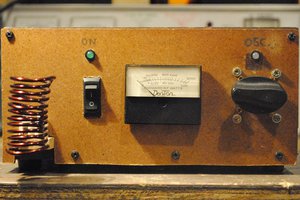This Tesla Coil is capable of generating a spark with a length of up to 40+ cm with just one transformer from an old microwave oven.
Generally the device contains few subassemblies:
- The power supply which consists of the following parts: Dimmer for controlling the power. In the original project, in place of this dimmer is a variac that is relatively expensive and difficult to find. The dimmer can be easily made according to the given schematic.
- Next, an old microwave Oven transformer
- Voitage doubler which is composed of two capacitors of 1 microfarad each, connected in parallel and a high voltage diode containing 24 diodes 1N4001 connected in series.
- The driver circuit with GU81 tube which is actually an oscillator with a certain frequency that depends on the capacitors and the primary coil of the Tesla transformer.

- Power supply for heating GU81 which should give 12V and at least 11A. In this case it is a power supply from an old server computer. In order to extend the life of the vacuum tube, it is desirable to first supply the heating for one minute through a serial resistor of 2.7 ohms / 10 Watts and then the resistor is short-circuited.
- And finally the primary and secondary coil of the Tesla Transformer. The success of the whole project depends on the correct preparation of this part.
Primary coil is wound on a PVC pipe with diameter of 17 centimeters. It consist 19 plus 7 turns of plastic insulated wire. It is best to wind with more windings with tapping points at each turn for the possibility of fine tuning.
The feedback coil is wound on the same body 1 to 2 cm above the primary coil and contains 21 windings of insulated copper wire with a diameter of 1 mm.
The secondary coil is wound on a PVC pipe with a diameter of 8 cm and contains 960 turns of insulated copper wire with a diameter of 0.25 mm.
First of all let me remind you that this circuit is a very dangerous one. The output voltage of this circuit is in Kilo volts and it can seriously injure you or kill you. Try this circuit only if you have enough experience dealing with high voltages. I have no responsibility on any hazards caused by the circuit. Be very careful. This is a humble request.
 mircemk
mircemk
 Discrete Electronics Guy
Discrete Electronics Guy
 Zach Armstrong
Zach Armstrong
 Nicholas Amrich
Nicholas Amrich